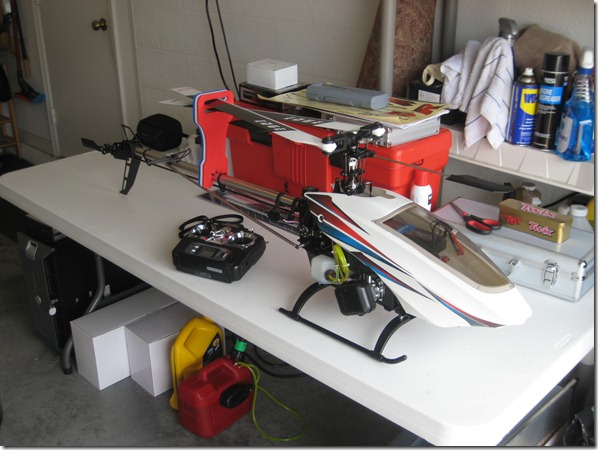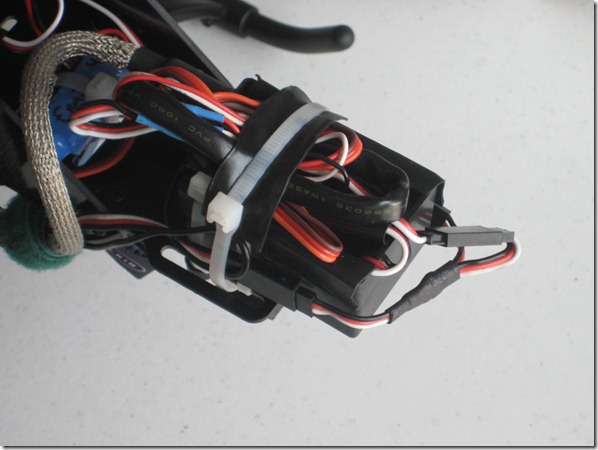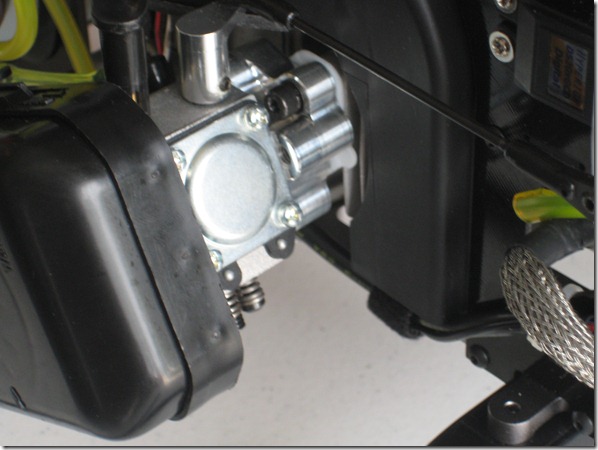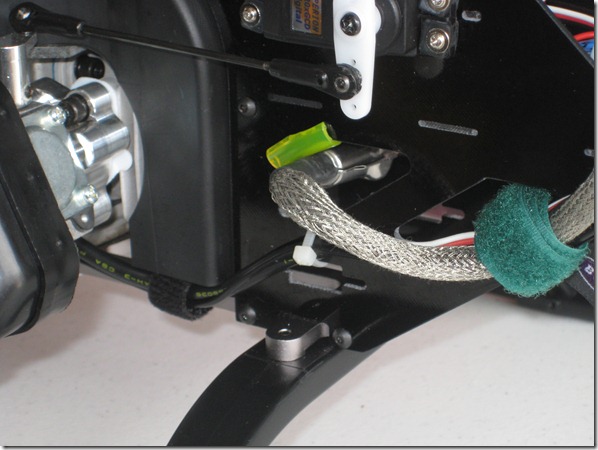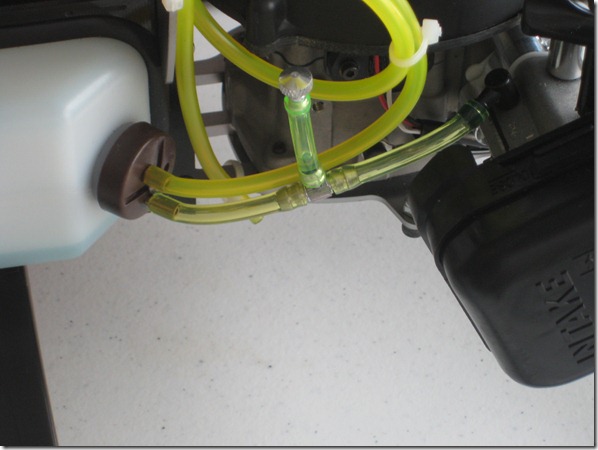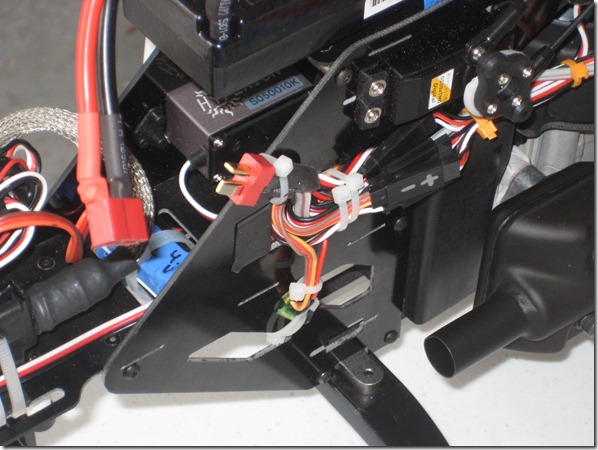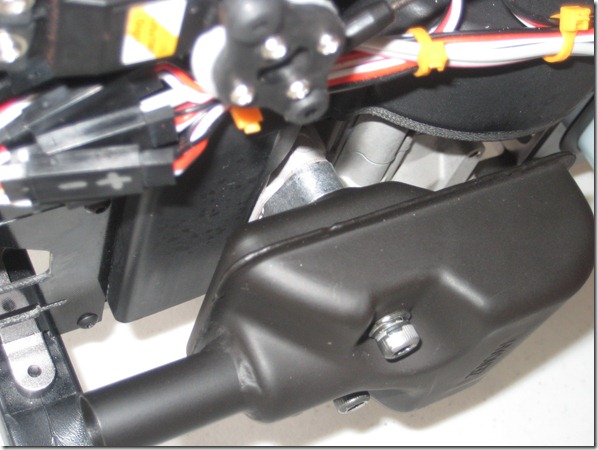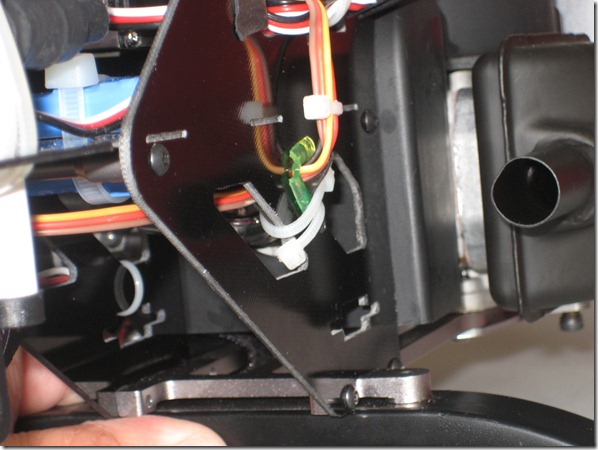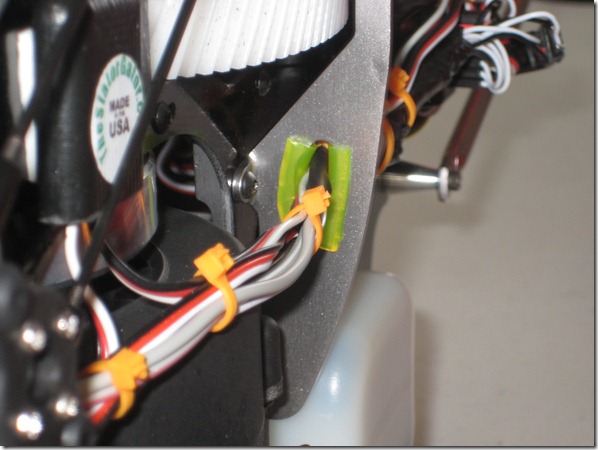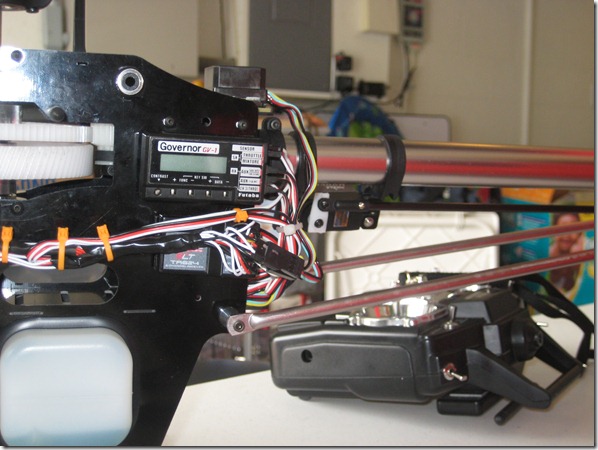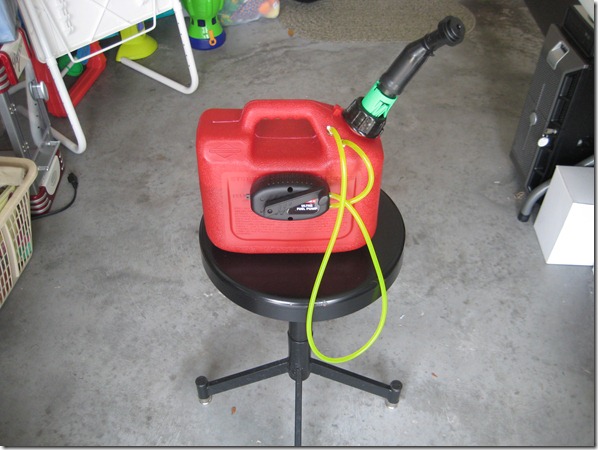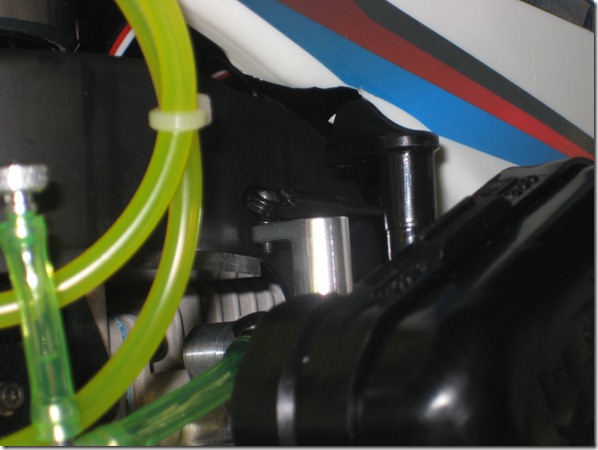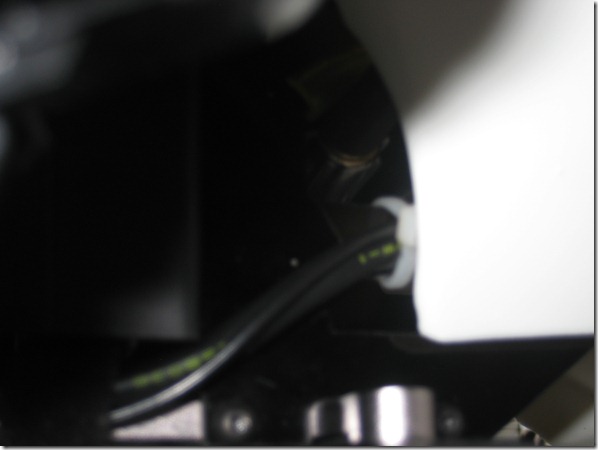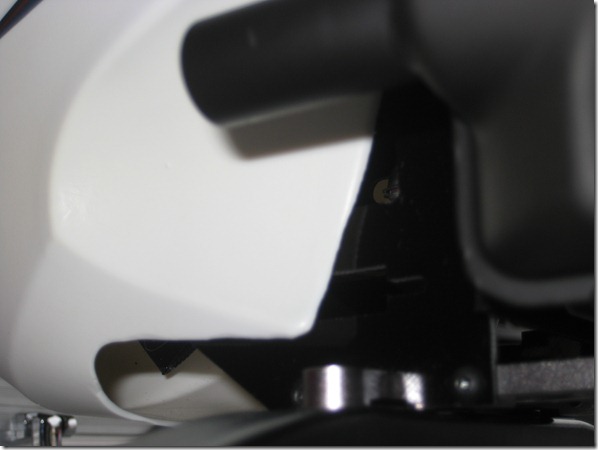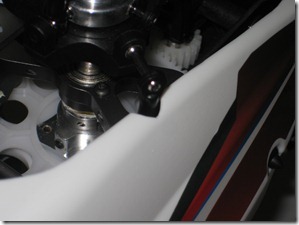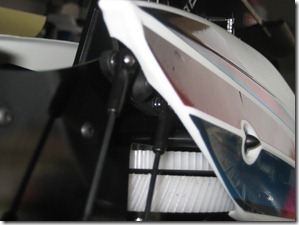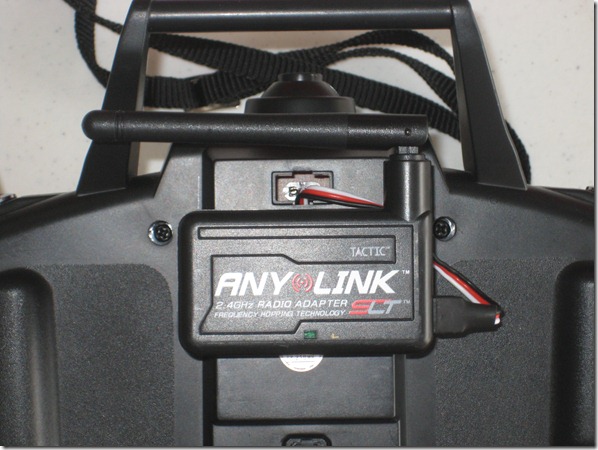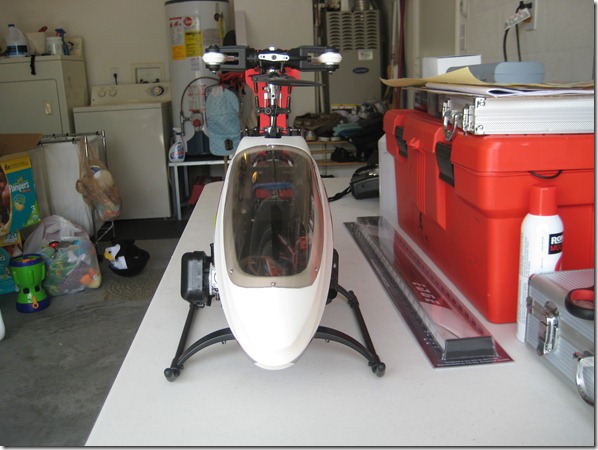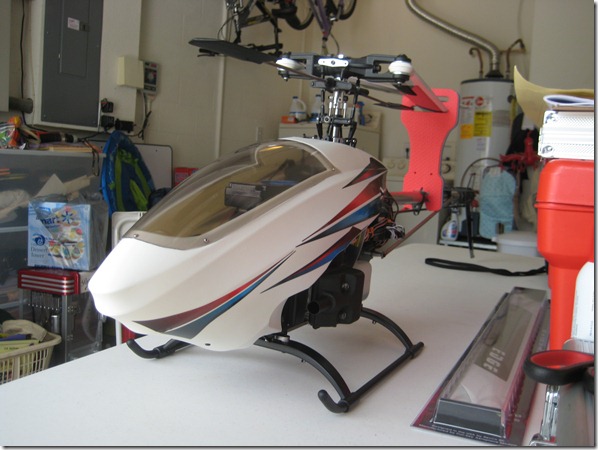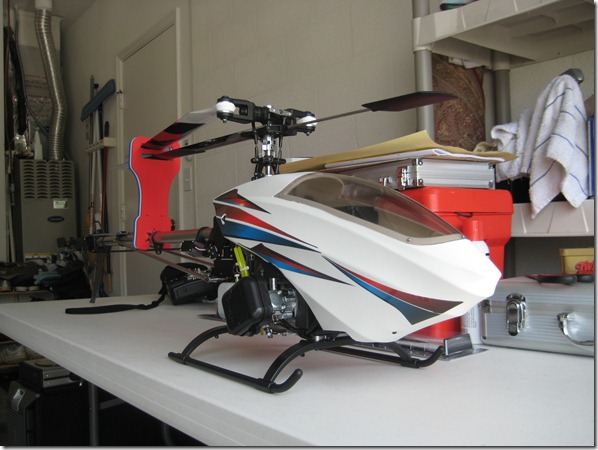First off, I’d like to apologize for jumping forward from mid-build to already done. The past few weeks have been an exceptional challenge work-wise so I’ve been building during the week to relax a bit so taking pictures and updating the blog have not been a huge priority. What I’ll do in this post is run through a few of the critical parts of the helicopter and post comments about adjustments that I’ve made as well as build notes, details, modifications, and other things the manual may have otherwise missed.
Last time we were together on the blog, the helicopter was built but missing blades, electronics, windshield, and it hadn’t been started yet. At this point, I’ve already started the helicopter and I’m about an 1/8th of a gallon into breaking in the engine (very slow process).
The first start took quite a few pulls but once it came alive the engine purred very nicely. My friend, Peter, helped me get the engine started (he took over after I had been pulling the starter for a few minutes). Once the engine idled for about 10 minutes, we cut it off, checked muffler bolts, let it cool, then started it again. We let it idle for a little while and then stopped it again to let it cool. The third time we fired it up, we ran the RPM up to the point where the clutch was engaging and got the blades spinning. I was running a slight negative pitch to keep the helicopter no the ground (flat pitch curve throughout the entire throttle/collective range so no lift off was possible). We did this to keep the helicopter on the ground but get through full clutch engagement and bring the rotor up to speed. I checked tracking and it was WAY off. A few other items of note were that the throttle servo was not closing the throttle all the way so the engine wouldn’t shut off (BAD), fuel lines had to be replaced since I used 1/8th inch lines and they were coming off the fittings (fuel leaking all over but this was fixed prior to first start). Other than those few things, everything went very smoothly! A quick note on the exhaust: break-in will have the engine running quite rich at lower RPM than typical for flying so you’ll be spitting out quite a bit of oil. Be ready to wipe down the canopy and any electronics if you run it without when using the muffler configuration that I am.
It was already late in the day so once we got the rotor up to speed a few times Peter flew his Radikal and then we left.
The next morning I worked on the head geometry back at my shop. I took the links off and got them very close to identical then eyeballed the angle on the head for lack of a pitch gauge that would fit the big Edge blades. I also tweaked the throttle servo and linkage to get the travel I wanted in order to fully close the throttle and cut off the engine via remote (I have a kill switch but no extra channel… long story on how I plan to fix that but more on that later). Finally, I set up the governor after testing the throttle points, dialed in 1600 rpm, and programmed pitch and throttle curves so that I would get zero pitch at half-stick and the governor would engage slightly below.
I headed back out to the field, started it up (much easier now) and brought the rotor RPM up. At this point, I had the option to take off so I kept that in mind. Once I was comfortable, I eased up on the collective and the helicopter effortlessly rose. I brought it up to eye level and checked the tracking… so close! I had put some blade tracking tape on the blades so figuring out which blade needed adjustment was easy. I set it down, shut off the engine, and adjusted the blades.
The next lift-off was smooth as well. Governor engagement and transition were almost invisible and once I brought the helicopter up to eye level I was rewarded with a nice solid rotor disc that was properly tracked! I hovered for another couple of tanks and made some slow forward, backward, and sideways sweeps to move the machine through the air and become familiar with it. I am so pleased with the way the entire setup went! The GY401 was at 75% and it was holding the tail rock solid but I may tweak it even more after engine break-in.
Here’s a shot of the finished helicopter in my shop. I have to be very honest and say that the thought of getting rid of my electrics has come to mind but I’m going to shelve it so I don’t do anything I will later regret.
The Zenoah EI (Electronic Ignition) module and cables up at the front. Note the 3M Rubber Electrical tape across the cables to protect them from the zip tie and along the edges of the EI module to protect the zip tie that holds it to the nose. I also used this tape below the EI module to keep it from sliding. I originally used some small wood shims to raise the module up and mount it per the instructions in the Zenoah manual. The engine’s vibration combined with the very sharp edges of the EI module ate right through the shims so they had to go. My engine voltage regulator is on top as you can see and the one for my radio, gyro, and governor is mounted below it on the same tray. Just FYI, my Stator Gator came with a servo style plug and the EI module and sensor come with a different plug. In the process of me “integrating” the Stator Gator, I tore up one of the plugs so I went ahead and converted everything to the servo-style plug. I used a servo “Y” cable to send signal from the sensor to both, the EI module and Stator Gator. It works flawlessly!
Here’s a good illustration of the B.H. Hanson aluminum isolator block that Al Chianelli sent me. It is pretty to look at and functional as well. it came with Teflon gaskets that help isolate heat and further eliminate leaks! You can also see the big stock Zenoah ugly air cleaner. Here in Florida, most of my flying fields are quite dusty so the air cleaner is a MUST.
I used Velcro in some areas to tie cables where they wouldn’t be interfacing with the sharp G10 edges (I’ve already had some damage due to vibration) and I installed split fuel tubing in other areas to protect cables. Here, you can see some of the tubing protecting the spark plug wire. A big note here on the spark plug wire: it requires some force to have it completely over the plug. What you’re looking for is the boot to cover the hex bolt part of the plug (thanks, Peter).
I split the tubing from the gas tank to the carburetor and added a “T” fitting with a tube and fuel dot to make refueling easier (another thanks to Peter). The original tube was longer and it was rubbing up against the air cleaner. An inspection after 5 flights showed that the air cleaner was already wearing into the tube. I shortened the hoses and now it is a taut fit (but not too tight). Also, note the vent tube that is aimed down after being coiled up a few times.
Here you can see my Deans’ plug being hugged by 3M rubber electrical tape and then strapped to the frame with a zip tie. This keeps it sturdy so I can plug it in and protects the cables from vibration and damage. There is also rubber electrical tape where the cables enter the frame and you can see my wiring harness with labeled plugs so I can interface the servos and power in the front with the electronics in the rear.
What I’m trying to illustrate here is the 1/2” exhaust spacer that Al from B.H. Hanson sent me. It allows the stock muffler to clear the canopy (in forward configuration) and saves me from having to do any ductwork to direct the exhaust away from the helicopter. You can see already on the cooling shroud traces of oil; break-in will be a bit messy, just have a rag ready to clean up.
Here we go again with a combination of split fuel tubing and rubber electrical tape to protect all of the interactions between the G10 frame and the electrical cabling. you can also see how one of the voltage regulators is under the other and strapped with one tie through the frame. I’ll inspect this after a few flights to ensure that the tie isn’t cutting into them.
One of the items that the manual doesn’t make mention of are some vertical frame stiffeners that also make for awesome supports to run cabling through. Again, make sure you protect the cabling with rubber tape or split fuel tubing to ensure they don’t get frayed or cut by the metal.
Here we have the rear electronics area. One of the nice things about the Radikal is that it has PLENTY of room for electronics within the helicopter. The down side is that there’s not a lot of access to them. I chose to side-mount the electronics so I could fine tune them as I needed to and have quick access. Once I’ve got things running the way I’d like, I may mount them inside the helicopter. If you zoom in on the picture, you’ll see the tail-end of my wiring harness with the power system described in my previous post. I made one adjustment to the diagram and that is that I left the ground cables intact and interconnected them to ensure that the ground signal would arrive at the servos cleanly.
My “gas station” made up of a standard run of the mill gas can with a Hangar 9 fuel pump, some Tygon tubing, and a Great Planes Filling Station Can Fitting Set. The fuel pick-up in the fitting set is filtered as well as the gas probe. This ensures a clean fuel supply and very efficient fueling operations. Also, note that the probe has a rubber gasket that the gasoline will eat up since it was designed for glow fuel. You will have to eventually replace the fuel probe.
The next few pictures will show canopy modifications I had to make to clear cables, bell cranks, and other areas. The first one is for the choke; in order to open it, I had to cut the canopy to make room for the choke lever.
In order to accommodate the engine ground and hall sensor cables as well as the spark plug cable, I had to cut the lip off the canopy on the carburetor side.
Over on the exhaust side, some of my cables were getting caught up in the canopy lip so I went ahead and cut that as well.
I had originally cut notches in the top of the canopy for the swash plate links to move through. I thought this would be enough but after doing some testing, I kept hearing the noise of something hitting the canopy so looked and found that the rear of the canopy on the carburetor side of the helicopter was hitting the rear bell crank.
I found one of the scariest glitches while testing on the bench. I had already flown the helicopter a few times and I was testing the throttle servo when it became unresponsive. I had noticed it a few times on the bench prior to this but had just dismissed it. When I diagnosed the problem, I found that the trainer port on my Futaba radio was not making full contact with the AnyLink jack. The AnyLink uses a standard servo plug for input so I grabbed one of my servo extension cables, cut it, and soldered one end directly to the board on the radio. This ensures a permanent and clean connection to the AnyLink and removes a failure point.
And now, enjoy a few shots of the finished helicopter. I’ll post some videos of the first flights shortly!

